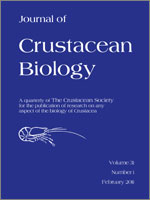Postlarvae and juveniles of pink shrimp were collected in the summers of 2005 and 2006 at three stations in northwestern Florida Bay, the main nursery ground of this species in South Florida. Collections were made at one- or two-hour intervals during three full moon nights and two new moon nights at depth intervals in the water column. Results of the five collections were consistent with the assumption that postlarvae use a flood-tide transport (FTT) to advance into the estuary by ascending in the water column during the dark-flood tide and resting near the bottom during the ebb tide. Evidence of a FTT were higher numbers of postlarvae per hour collected during the flood tide vs. ebb tide and the large number of postlarvae collected with highest velocity flood tide currents. ANOVA indicated significant differences in the number of postlarvae collected between tidal stages and moon phases, but not among depths. Postlarvae were more abundant during new moon than full moon. We also found different patterns of postlarval distribution between the new and full moon. During the new moon, a large peak of postlarvae occurred coincident with highest current speeds, whereas, with one exception, during the full moon postlarvae were more abundant in the second half of the flood period near the slack tide. In contrast, juveniles exhibited a behavior and migratory pattern opposite to that of postlarvae. ANOVA indicated significant differences between the number of juveniles captured between tidal stages and among depths, but not between moon phases. Juveniles were found almost exclusively near the surface on the ebb tide. Significantly larger juveniles were captured on the dark-ebb rather than on the dark-flood tide during both moon phases, suggesting that older juveniles were leaving the Bay on the ebb tide.
How to translate text using browser tools
1 February 2011
Field Observations on Selective Tidal-Stream Transport for Postlarval and Juvenile Pink Shrimp in Florida Bay
Maria M. Criales,
Michael B. Robblee,
Joan A. Browder,
Hernando Cardenas,
Thomas L. Jackson
ACCESS THE FULL ARTICLE
It is not available for individual sale.
This article is only available to subscribers.
It is not available for individual sale.
It is not available for individual sale.

Journal of Crustacean Biology
Vol. 31 • No. 1
February 2011
Vol. 31 • No. 1
February 2011
Florida Bay
pink shrimp
selective tidal stream transport




